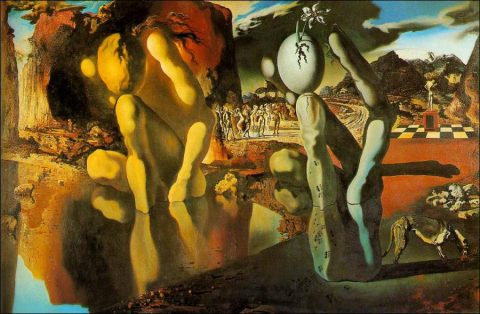So we get to the phenomenon of aesthetic perception, which has many subtle tentacles linking it with the other phenomena. Perception in some sense–over and above the subjective response, if this is to count at all–certainly seems to be involved in aesthetic experience, be it on the artist’s part or on ours who behold his work. Of course, it will differ from the perceiving which is scientific observing, but without losing its own sort of objectivity.
Without this, evaluative criticism would not be feasible. And it is feasible. What is puzzling about all this is that, though some such objectivity is presupposed, apparently with the implication that aesthetic quality is there in the art object, yet the best artists and the most authoritative connoisseurs will, while looking straight at it, disagree as to what is to be seen in it. This is the basic disagreement, and it is amazing in this connection how changing the title of the composition modifies its perceptible content.
We need a philosophy of titles of works of art. Superimposed on this stratum of agreement or disagreement of descriptions and interpretations is the level of evaluation, where judgments of aesthetic excellence are made. Here, too, unanimity is not guaranteed even among experts, and this phenomenon teases us into a closer scrutiny of how value terms are used in art appreciation and criticism.
Is it the function of these terms to refer to (or name, or describe) any qualities at all in the work of art? Curious answers have been given this question, answers spawned by the basic phenomenon of the way the artist and art critic look at things and what this reveals to them. With this mode of perception goes the appropriate mode of expression, and the logic of this is a real teaser, as is the logic of its critical assessments.
What complicates this question is the variety of the arts, reflected, for example, in the title of Paul Weiss book Nine Basic Arts. Types of statements that make important sense in relation to some of them are inept in application to others. In view of, say, a Hindemith quartet or a Braque cubistic painting on one hand and Moby Dick on the other, a general answer to the question, what is art? is hazardous.
And the question, asked in general terms to invite the general answer, now concerns mostly amateur philosophers of art. But surely there is something in common, some thread that runs through them all, making them of the same general kind? Of course; but the phenomenal thing about this is that the shared characteristic may be quite insignificant or unrevealing when it is detected–not at all what one was after in the pursuit of understanding of the arts. To use an old term, it does not turn out to be the essence. So one begins to wonder about the essence, whether it is a will-o’-the-wisp.
A final phenomenon is brought to mind by generality. A good work of art is said to be universally significant, and yet is quite unique inasmuch as it seems to be the occasion for as many different individual appropriations of it as there are individuals. In short, though it does not address us in the language of generalization, yet what it means seems universally true. This sense of “true” is as phenomenal as anything. It has suggested to at least one philosopher of art that a work of art–even a Henry Moore petrified figure–is a proposition, couched in a certain way.
There are other phenomena of art, but those we have mentioned will suffice. Plato noticed and remarked on the fact that some objects of ordinary sense perception tease us into thinking about them because they are phenomenal, puzzling. Unfortunately, he pictured this situation as containing nascent contradictions, and therefore to be transcended in favor of another kind of objects: the abstract, imperceptible, consistent objects of thought, corresponding to concepts.
So, in one mood at least, he looked on art with disfavor because of its reliance on perception instead of conception. But the only philosophy of art that has a chance will dwell upon and among the perceptible phenomena of art without tearing and eventually annihilating their delicate tissues. This sort of scrutiny, and the theory that takes shape in this contagious intimacy with the phenomena, I call phenomenological.
Let us turn to the phenomenology of art–a sort of descriptive metaphysics that will avoid reducing or elevating art to something it is not, and will avoid replacing it by something that more properly goes under another category. Of course, art has relations to all of these, but the fair philosopher of art will prevent such relatedness from too omnivorously devouring art and denaturing it in a sort of digestive metamorphosis that is sometimes honorifically called a rational reconstruction. Art has already suffered enough from such alleged explanations, as so many other delicate phenomena have, such as the impressions of common sense.
So we turn to the phenomenological scrutiny and account of the phenomena of art. Some hypersensitive phenomenologists have said that this involves only an illuminating verbal activity, not a theory-keine Lehre, sondern eine Tätigkeit (Wittgenstein). But a theory of sorts is going to emerge. It will be neither inductive nor deductive in the scientific way, but will make an exhibitive sort of sense, reminding the reader of certain things he already knows and assisting him to see them afresh in a way that shows him also how the key terms of the discipline are used.
Hits: 117
